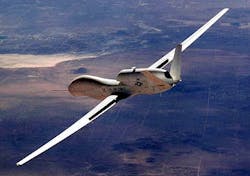Northrop Grumman to build three Global Hawk long-range surveillance UAVs for government of Japan
Officials of the Air Force Life Cycle Management Center at Wright-Patterson Air Force Base, Ohio, are asking the Northrop Grumman Aerospace Systems segment in San Diego to build the three Global Hawk UAVs for Japan, as well as enhanced sensor suites for each UAV, and two ground control systems.
Global Hawk is a high-altitude, long-range UAV that provides near-real-time intelligence, surveillance and reconnaissance (ISR) over large areas. The Block 30 Global Hawk carries sophisticated imaging and electronic signals sensors on missions that can exceed 32 hours.
The Block 30M Global Hawk is configured to carry the Raytheon Enhanced Integrated Sensor Suite (EISS) and the Northrop Grumman Airborne Signals Intelligence Payloads (ASIP) for situational awareness and intelligence-gathering across huge areas of land, Northrop Grumman officials say.
The Block 30 Global Hawk with its ISR capabilities is designed to augment or replace the Air Force U-2 high-altitude manned reconnaissance aircraft.
The EISS on the Global Hawk provides reconnaissance imagery using an all-weather synthetic aperture radar/moving target indicator (SAR/MTI), a high-resolution electro-optical (EO) digital camera, and a third-generation infrared (IR) sensor, all operating through a common signal processor.
The Raytheon EISS enables Global Hawk to survey vast geographic regions with image quality that can distinguish various types of vehicles, aircraft, people, and missiles, even through bad weather, day or night.
The EISS transmits imagery and position information from altitudes as high as 60,000 feet with near real-time speed with night vision and radar detection capabilities.
The Global Hawk Block 30 is 47.6 feet long, has a wingspan of 130.9 feet, can fly as high as 60,000 feet, can carry payloads as heavy as 3,000 pounds, and can fly for as long as 32 hours on one load of fuel.
On this contract Northrop Grumman will do the work in San Diego, and should be finished by September 2022. For more information contact Northrop Grumman Aerospace Systems online at www.northropgrumman.com, or the Air Force Life Cycle Management Center at www.wpafb.af.mil/aflcmc.
Ready to make a purchase? Search the Military & Aerospace Electronics Buyer's Guide for companies, new products, press releases, and videos
